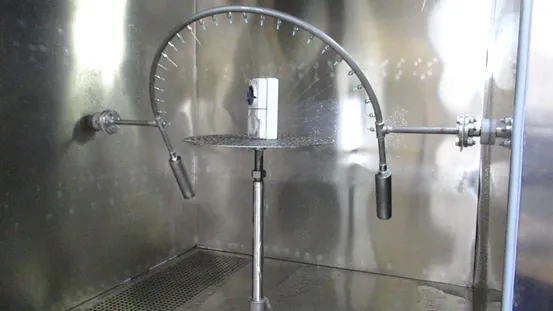SAE J575 Dust and Water Ingress Protection Testing
The SAE J575 standard is a critical benchmark in the automotive industry, specifying tests for dust and water ingress protection of connectors. This testing ensures that electrical components are robust enough to withstand harsh environmental conditions encountered during vehicle operation.
The standard primarily focuses on the ingress protection (IP) ratings assigned by the International Electrotechnical Commission (IEC). The IP rating consists of two digits: the first digit represents resistance against solid objects and dust, while the second digit indicates resistance to water. For instance, an IP67 rating signifies that a connector is fully protected against dust and can operate in water depths up to 1 meter for durations specified by the standard.
SAE J575 testing involves exposing connectors to various environmental conditions that simulate real-world scenarios encountered during vehicle use. This includes exposure to sand, salt spray, immersion in water, and even temperature cycling. The goal is to determine how well a connector can maintain its functionality under these challenging conditions.
The process begins with the careful preparation of the specimen. Connectors are cleaned according to SAE J575 requirements to ensure consistent test results. After cleaning, they undergo drying in an oven or by other means as specified. The drying process is crucial because it ensures that any moisture present does not interfere with the testing.
Following preparation, connectors are subjected to dust ingress tests using a standardized sand chamber. This chamber simulates exposure to airborne particles and dust. The test involves introducing known quantities of dust into the chamber and then measuring how much dust adheres to the connector surfaces after a set time.
The water ingress testing follows similar principles but uses various spraying techniques to evaluate resistance against different forms of water intrusion. This includes high-pressure jets, immersion, and even submersion tests depending on the IP rating requirements. The test conditions are designed to replicate real-world exposure to rain, snow, or other precipitation.
The results from these tests are meticulously recorded and analyzed. The primary focus is on identifying any changes in electrical performance, mechanical integrity, and overall functionality of the connector. If a connector fails any part of this testing, it must be reworked or replaced before further testing can proceed.
Once all tests have been completed successfully, detailed reports are generated detailing each step of the process and the results obtained. These reports serve as essential documentation for compliance with automotive industry standards and specifications.
Why Choose This Test
- Achieve stringent SAE J575 compliance requirements.
- Evaluate the robustness of connectors in real-world environments.
- Ensure product reliability and enhance customer satisfaction.
- Reduce risks associated with field failures due to environmental factors.
- Promote consistent quality across all production batches.
- Support regulatory compliance for automotive components.
Environmental and Sustainability Contributions
By ensuring that connectors meet stringent SAE J575 standards, manufacturers contribute significantly to environmental sustainability. Robust connectors reduce the likelihood of premature failure, which in turn minimizes the need for frequent replacement and repair. This extends product life cycles, reducing waste and resource consumption.
The durability provided by these tests also helps in minimizing vehicle downtime, leading to more efficient use of resources such as fuel and labor. Additionally, compliant products are less likely to contribute to environmental degradation through premature disposal or improper recycling.
Competitive Advantage and Market Impact
Meeting SAE J575 standards can provide significant competitive advantages in the marketplace. Consumers increasingly value reliability, safety, and longevity when purchasing automotive components. By demonstrating adherence to these rigorous testing protocols, manufacturers can position themselves as leaders in quality and innovation.
The ability to pass such stringent tests also opens up new market opportunities by allowing products to be certified for use in a broader range of applications within the automotive industry. This can include expanded geographical markets where environmental conditions are more challenging or unpredictable.





